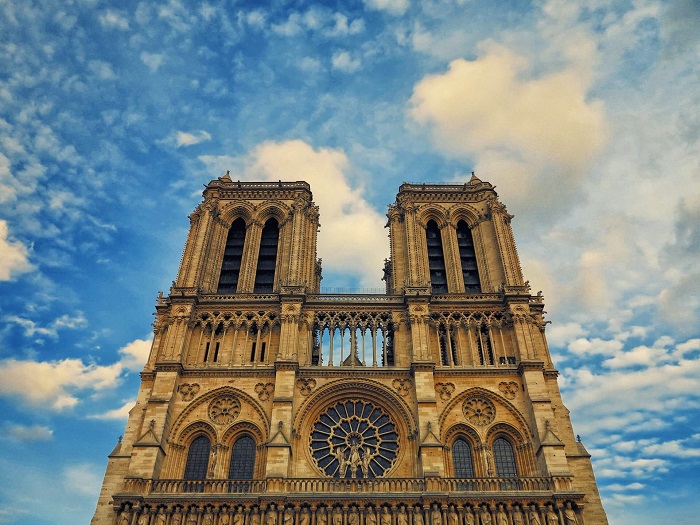ISABEL RUBIO ARROYO | Tungsteno
Notre Dame is one of the oldest and largest cathedrals in the Gothic style in the world. The fire it suffered in April 2019 damaged some parts of its structure and allowed us to discover one of its secrets: the use of iron in its construction. We analyse this and other curiosities hidden in one of the most emblematic churches in Paris.
The cathedral that hid a forest in its interior
Notre Dame is one of the oldest Gothic cathedrals in France. Its construction began in the mid-12th century and took about 200 years to complete. The structure is notable for its tall towers, stained glass windows and ornate detailing. Between the high stone arches and the cathedral roof, there was a space nicknamed "The Forest" because of the large number of wooden beams it contained. Each one came from an individual tree and an estimated 1,300 oak trees were supposedly felled to create the roof structure.
Above all, it is an emblematic monument in the history of France. As well as inspiring many artists and writers, such as Victor Hugo, it has been the site of many important events: from the coronation of Napoleon in 1804 to the Te Deum mass on 26 August 1944 to celebrate the liberation of Paris from German forces, and the Requiem Masses of the Presidents of the Republic, Charles de Gaulle, Georges Pompidou and François Mitterrand.
Notre-Dame de Paris is one of France's most iconic monuments. Credit: French Ministry of Culture.
The fire that shook the world
"Notre Dame has traversed the centuries, surviving both wars and revolutions alike, and presenting an immutable face to the changes in our societies," says the French Ministry of Culture. The cathedral, which has undergone numerous restorations, suffered one of the most tragic events in its history on 15 April 2019. A fire broke out on the roof and quickly spread, destroying the cathedral’s iconic spire and roof and causing extensive damage inside.
Notre Dame cathedral suffered a major fire on April 15, 2019. Credit: France 24 English.
"The fire at Notre Dame Cathedral in Paris is a tragedy for all French people," said Franck Riester, Minister of Culture, a day after the incident that shocked the world. The Ministry of Culture described the emotions aroused by the fire as follows: "Shock, astonishment, international upheaval, drama, disaster, tragedy, catastrophe, trauma, sadness, mourning... there was no shortage of words to describe how we all felt during this shockwave, the consequences of which we are still assessing."
The high vaults were severely damaged by the fire, threatening their stability. An expert’s report on 23 April 2019 indicated that the gaps in the vaults, the damp atmosphere after the heat of the fire and, above all, the lead-laden dust that penetrated the great organ were all detrimental to its preservation. Emergency measures to secure the cathedral were decided upon the morning after the fire, and since then various architects and engineers have been working on the conservation and restoration of the ancient structure.
The evening after the fire, French President Emmanuel Macron promised that reconstruction would take five years. Credit: French Ministry of Culture.
The fire revealed thousands of iron staples
The fire and restoration work led to a surprising discovery: Notre Dame is the first Gothic cathedral known to have used iron in its construction. A group of scientists analysed iron staples up to a half a metre long used to reinforce the stones and other features of the tallest building of its time. "The fact that the framework burned made some staples that could not be visible before appear to us," Maxime L'Héritier, one of the researchers, told the New Scientist website.
It was very innovative at the time. "You realise that they were doing things that were like the Empire State Building around 1930, or like the Burj Khalifa in Dubai—really extraordinary stuff for the time," Robert Bork, a professor of art history at the University of Iowa, told New Scientist. He says it is comparable to "the moonshot in the 1960s and some of the big high-tech initiatives now."
Proposals for the restoration were many and varied. One suggested replacing the cathedral’s roof with a large swimming pool while another wanted to recover the experience of walking through "The Forest". Since the fire, the structure has been closed to the public. The evening after the fire, French President Emmanuel Macron promised that reconstruction would take five years. If all goes according to plan, it will be ready to welcome new visitors in 2024. Before the tragedy, it was the most visited monument in France and Europe, with nearly 14 million visitors a year, according to the Ministry of Culture.
Tungsteno is a journalism laboratory to scan the essence of innovation.
